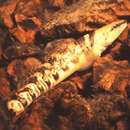en
names in breadcrumbs


Etheostoma nianguae és una espècie de peix de la família dels pèrcids i de l'ordre dels perciformes.[2]
Els ous són enterrats en el substrat.[5]
És d'aigua dolça, bentopelàgic i de clima subtropical (39°N-37°N).[6] Els adults acostumen a viure en gorgs de fons rocallós, rierols i rius petits o mitjans.[3]
Es troba a Nord-amèrica: conca del riu Osage (conca del riu Missouri al sud de Missouri, els Estats Units).[7][8][9][4][10][11][12][13][14][15][16][6]
Etheostoma nianguae és una espècie de peix de la família dels pèrcids i de l'ordre dels perciformes.
The Niangua darter (Etheostoma nianguae) is a species of freshwater ray-finned fish, a darter from the subfamily Etheostomatinae, part of the family Percidae, which also contains the perches, ruffes and pikeperches. It is endemic to Missouri, United States. It is found only in the Osage River Basin of central Missouri where its range historically included the Sac River, Pomme de Terre River, Niangua River, Big Tavern Creek, and Maries River.[4] It is a federally listed threatened species of the United States.[2][3]
The Niangua darter is a slender, silvery-brown fish with about ten vertical dark bars with brown centers alternating with orange undulating lines. There are two small black spots at the base of the tail fin. The color is accentuated in breeding males which have bright orange and green bars along the flank and orange and green bands on the dorsal and tail fins. The maximum size of this fish is about 13 cm (5 in) but a more common size is 7.3 cm (3 in).[5]
Adult Niangua darters move from pools and slow runs to gravel riffles prior to spawning. The spawning season runs from mid-March to early June, but most of the breeding occurs in April. After spawning, Niangua darters return to the pools and stream runs. Young darters can reach sexual maturity after one year and can live up to four years, but few survive longer than two years.[6]
Niangua darters eat the nymphs of stoneflies and mayflies, and other aquatic insects.[7]
Niangua darters live in clear upland creeks and small to medium-sized rivers with slight to moderate currents.[8] They require continuously flowing streams with silt-free gravel and rock bottoms. These streams typically drain hilly areas with chert or dolomite bedrock. Niangua darters are found most of the year in shallow pools, margins, and stream runs.
Niangua darters occur only in Missouri in counties in the Osage River basin, including: Osage, Maries, Miller, Camden, Hickory, Dallas, Benton, Greene, Webster, Cedar, Polk, and St. Clair. The Niangua Darter was historically widespread and abundant in these rivers and streams.
The Niangua darter has declined in numbers during the last 30 years, primarily due to habitat loss from reservoir construction, and stream channelization. Reservoirs isolated populations of Niangua Darter and barred them from dispersing between suitable habitats. Land clearing and increased amounts of sediment and nutrients have also caused declines in Niangua Darter populations. As a consequence of these factors, the IUCN has listed this fish as being "Vulnerable".[1]
The Niangua darter (Etheostoma nianguae) is a species of freshwater ray-finned fish, a darter from the subfamily Etheostomatinae, part of the family Percidae, which also contains the perches, ruffes and pikeperches. It is endemic to Missouri, United States. It is found only in the Osage River Basin of central Missouri where its range historically included the Sac River, Pomme de Terre River, Niangua River, Big Tavern Creek, and Maries River. It is a federally listed threatened species of the United States.
Etheostoma nianguae es una especie de peces de la familia Percidae en el orden de los Perciformes.
Los machos pueden llegar alcanzar los 13 cm de longitud total.[2]
Se encuentran en Norteamérica: Misuri.
Etheostoma nianguae Etheostoma generoko animalia da. Arrainen barruko Percidae familian sailkatzen da.
Etheostoma nianguae Etheostoma generoko animalia da. Arrainen barruko Percidae familian sailkatzen da.
Etheostoma nianguae is een straalvinnige vissensoort uit de familie van de echte baarzen (Percidae).[1] De wetenschappelijke naam van de soort is voor het eerst geldig gepubliceerd in 1887 door Gilbert & Meek.
Bronnen, noten en/of referentiesEtheostoma nianguae é uma espécie de peixe da família Percidae.
É endémica dos Estados Unidos da América.
Etheostoma nianguae é uma espécie de peixe da família Percidae.
É endémica dos Estados Unidos da América.
Etheostoma nianguae là một loài cá thuộc họ Percidae. Chúng là loài đặc hữu của Hoa Kỳ và chỉ được tìm thấy ở vùng sông Niangua thuộc trung tâm Missouri.
Etheostoma nianguae là một loài cá thuộc họ Percidae. Chúng là loài đặc hữu của Hoa Kỳ và chỉ được tìm thấy ở vùng sông Niangua thuộc trung tâm Missouri.
尼氏鏢鱸為輻鰭魚綱鱸形目鱸亞目河鱸科的其中一種,被IUCN列為次級保育類動物,分布於美國密蘇里州中南部的Osage河流域,體長可達13公分,棲息在岩石底質的水塘、溪流。